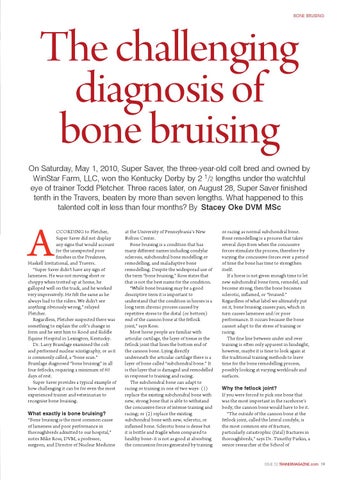bone bruising issue 32.qxd:Jerkins feature.qxd
26/11/10
14:00
Page 2
BONE BRUISING
The challenging diagnosis of bone bruising On Saturday, May 1, 2010, Super Saver, the three-year-old colt bred and owned by WinStar Farm, LLC, won the Kentucky Derby by 2 1/2 lengths under the watchful eye of trainer Todd Pletcher. Three races later, on August 28, Super Saver finished tenth in the Travers, beaten by more than seven lengths. What happened to this talented colt in less than four months? By Stacey Oke DVM MSc
A
CCORDING to Pletcher, Super Saver did not display any signs that would account for the unexpected poor finishes in the Preakness, Haskell Invitational, and Travers. “Super Saver didn’t have any sign of lameness. He was not moving short or choppy when trotted up at home, he galloped well on the track, and he worked very impressively. He felt the same as he always had to the riders. We didn’t see anything obviously wrong,” relayed Pletcher. Regardless, Pletcher suspected there was something to explain the colt’s change in form and he sent him to Rood and Riddle Equine Hospital in Lexington, Kentucky. Dr. Larry Bramlage examined the colt and performed nuclear scintigraphy, or as it is commonly called, a “bone scan.” Bramlage diagnosed “bone bruising” in all four fetlocks, requiring a minimum of 60 days of rest. Super Saver provides a typical example of how challenging it can be for even the most experienced trainer and veterinarian to recognise bone bruising. What exactly is bone bruising? “Bone bruising is the most common cause of lameness and poor performance in thoroughbreds admitted to our hospital,” notes Mike Ross, DVM, a professor, surgeon, and Director of Nuclear Medicine
at the University of Pennsylvania’s New Bolton Center. Bone bruising is a condition that has many different names including condylar sclerosis, subchondral bone modelling or remodelling, and maladaptive bone remodelling. Despite the widespread use of the term “bone bruising,” Ross states that that is not the best name for the condition. “While bone bruising may be a good descriptive term it is important to understand that the condition in horses is a long term chronic process caused by repetitive stress to the distal (or bottom) end of the cannon bone at the fetlock joint,” says Ross. Most horse people are familiar with articular cartilage, the layer of tissue in the fetlock joint that lines the bottom end of the cannon bone. Lying directly underneath the articular cartilage there is a layer of bone called “subchondral bone.” It is this layer that is damaged and remodelled in response to training and racing. The subchondral bone can adapt to racing or training in one of two ways: (1) replace the existing subchondral bone with new, strong bone that is able to withstand the concussive force of intense training and racing; or (2) replace the existing subchondral bone with new, sclerotic, or inflamed bone. Sclerotic bone is dense but it is brittle and fragile when compared to healthy bone- it is not as good at absorbing the concussion forces generated by training
or racing as normal subchondral bone. Bone remodelling is a process that takes several days from when the concussive forces stimulate the process, therefore by varying the concussive forces over a period of time the bone has time to strengthen itself. If a horse is not given enough time to let new subchondral bone form, remodel, and become strong, then the bone becomes sclerotic, inflamed, or “bruised.” Regardless of what label we ultimately put on it, bone bruising causes pain, which in turn causes lameness and/or poor performance. It occurs because the bone cannot adapt to the stress of training or racing. The fine line between under and over training is often only apparent in hindsight, however, maybe it is time to look again at the traditional training methods to leave time for the bone remodelling process, possibly looking at varying workloads and surfaces. Why the fetlock joint? If you were forced to pick one bone that was the most important in the racehorse’s body, the cannon bone would have to be it. “The outside of the cannon bone at the fetlock joint, called the lateral condyle, is the most common site of fracture, particularly catastrophic (fatal) fractures in thoroughbreds,” says Dr. Timothy Parkin, a senior researcher at the School of
ISSUE 32 TRAINERMAGAZINE.com 19
